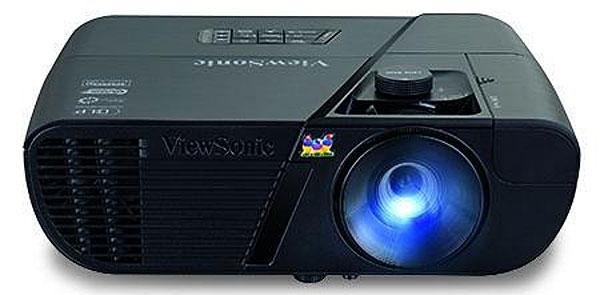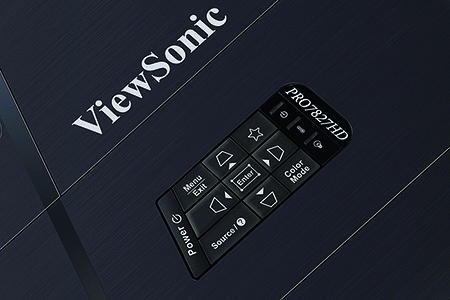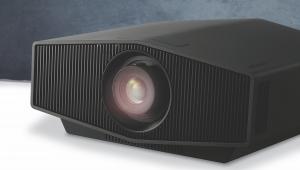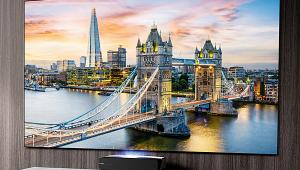ViewSonic Pro7827HD review

 The latest in ViewSonic's LightStream range, the Pro7827HD certainly packs in the features. This modestly priced DLP single-chipper is evidently aimed at the home cinema crowd, with its native 3D support, REC.709 picture preset, ISF modes and eye-catching claimed contrast ratio of 22,000:1.
The latest in ViewSonic's LightStream range, the Pro7827HD certainly packs in the features. This modestly priced DLP single-chipper is evidently aimed at the home cinema crowd, with its native 3D support, REC.709 picture preset, ISF modes and eye-catching claimed contrast ratio of 22,000:1.
Yet its remote control is equipped with a laser pointer. Perhaps useful to film buffs who want to spotlight continuity errors to their chums. This sort of thing is, of course, common in the world of PJs sold as office gear.
Despite this – and, for that matter, a built-in mono speaker and presentation timer – home cinema is definitely where the Pro7827HD is at. It's based around a Full HD DarkChip3 DMD with TrueBlack enhancement, used in conjunction with an RGBRGB colour wheel that ViewSonic refers to as Cinema SuperColor.
Then there's the connectivity of this fairly compact matt-black unit. Sure, there's a businesslike VGA/D-Sub terminal for PCs, complete with loopthrough output. But also on offer are twin HDMI inputs, with integrated MHL support, in addition to composite, component and (a fast-disappearing sight, this) S-video terminals.
Two HDMIs? Not quite. A compartment to the right of the lens controls is concealed by a cover; remove it and you'll discover a third HDMI port, alongside a trailing micro-USB power cable. It's intended for ViewSonic's optional wireless HDMI upgrade, the £100 WPG-300.
But it can instead accommodate other devices of similar dimensions; I used a Roku Streaming Stick, for example, giving the Pro7827HD a smart TV garnish. Plug it all in, clip the cover and you'd never know it was there. Just remember to switch on the USB power (buried in the MHL Settings menu) or it won't work.
On the menuThe Pro7827HD carries a user interface that positively brims with options, most of which influence the image thrown. There are the usuals – rear/front, table/ceiling, 3D settings, eco lamp mode, brightness, contrast and so on. Vertical lens shift is offered, as well as digital vertical and horizontal keystone correction as a last resort for those who can't position their PJ optimally. There's also the unusual ability to 'distort' corners so that an image appears uniformly rectangular (called 4 Corner Function). Other menu options include a sleep-timer and wall-colour compensation should you be throwing the ViewSonic's images onto, say, a light blue wall. I'm sure someone is.
Then we have the colour modes, including the aforementioned REC.709 option. Full control over parameters like colour temperature and gamma are provided. Each input can remember different permutations of settings, so you can optimise pictures for the connected source. There are ISF Day and Night modes should you be getting the PJ professionally calibrated – a password is needed to get into the relevant setup menus to prevent twiddling by the ISF-uncertified. AV tweakers will, however, appreciate that the password is given in the manual...
The ViewSonic offers a medium-throw lens. To give you some idea, a 3m (diagonal) 16:9 picture needs a minimum projection distance of 3m. So unless you have a particularly large screen, 'overlap' problems might be encountered in some scenarios – even with minimum zoom. You can use the electronic zoom's reduction feature to make the picture smaller. But that kills resolution.
Another limitation (for occasional users, at any rate) is that only one of the three feet (the front one) is adjustable. On the plus side, ViewSonic supplies a neat plastic cover that fits the rear panel, hiding all the connectors.

Although no doubt of limited interest to HCC readers, the onboard audio system was surprisingly effective – when, that is, it worked properly. On other occasions the onscreen displays had a mind of their own. Suddenly, keystone would start adjusting itself of its own accord. A second review sample was free of such foibles. Yet although lag is short (around 50ms), both units could take time to lock into a source; onscreen 'source search... detected' messages became annoying.
But I found it worth persisting, as this projector punches way beyond its weight in performance terms. Using the REC.709 setting, combined with the eco lamp mode, black levels really impress while fan noise is reduced to an acceptable whirr. Star Wars: The Force Awakens, a reference-quality Blu-ray, is done full justice here – whether it's the intricacy of the Jakku Starship Graveyard's scuttled Imperial Star Destroyers, or the Millennium Falcon speeding against a backdrop of inky expanse punctuated by countless stars. Plenty of action here, and while the Pro7827HD isn't immune to movement judder it seldom intrudes.
The rainbow effect came as a complete surprise, because – for me, anyway – there was so little of it to distract. A neat trick for a single-chip DLP model.
The Force Awakens' Imperial rally, meanwhile, reveals plenty of fine detail and cinematic punch, and not just in the massed Stormtroopers. The crimson-red backdrop (a nod to Nazi Germany) is portrayed with a film-like vividness. In general, bright colours are handled with aplomb. Even subtler flesh tones also fare well, especially after careful calibration. In short, this is a damn fine effort; not so long ago, you would have paid thousands to get visuals of this standard.
While no 3D spex are in the box, I can confirm that the Pro7827HD will work quite happily with DLP-Link active-shutter glasses; an Acer pair I had to hand delivered excellent results. The pan around the spaceship's exterior in Chapter 3 of Prometheus is both acceptably smooth and offers palpable, immersive depth. The star-map sequence later in the movie saw the complex patterns resolved with panache.
Enjoy the viewViewSonic should be congratulated for the performance of Pro7827HD – set it up correctly, and its pictures are clean, dynamic, tonally balanced and unfatiguing over long viewing periods. The only serious complaints I have are practical matters – source settling and a cooling fan that remained active long after the projector was shut down. The specification here is great, there's plenty to play with and that hidden HDMI input is a neat touch. Good work.
Specification
3D: Yes. Active (glasses optional) 4K: No. 1,920 x 1,080 Full HD Connections: 3 x HDMI (v1.4); USB (mouse emulation/power); RS232; 12V trigger; composite video; component video; S-video; VGA (15-pin D-sub) input/output; 2 x 3.5mm audio inputs; 3.5mm output Brightness (claimed): 2,200 Lumens Contrast (claimed): 22,000:1 Zoom: 1.3x (optical) Dimensions: 316(w) x 104(h) x 228(d)mm Weight: 2.6kg
Features: DLP DarkChip3 imaging device; vertical lens shift; ISF Day and Night modes; REC.709 preset; RGBRGB colour wheel; 3D DLP-Link; throw ratio 1.1-1.5:1; MHL support; 10W speaker system; 'eco' and 'super eco' modes; life of lamp up to 6,500 hours in 'super eco' mode
 |
Home Cinema Choice #351 is on sale now, featuring: Samsung S95D flagship OLED TV; Ascendo loudspeakers; Pioneer VSA-LX805 AV receiver; UST projector roundup; 2024’s summer movies; Conan 4K; and more
|























































